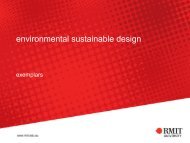Finalise Design Example
2017 Student Project
2017 Student Project
Create successful ePaper yourself
Turn your PDF publications into a flip-book with our unique Google optimized e-Paper software.
i MORE INFORMATION<br />
The Land<br />
Planning permits relate to the use and development of the land. It is<br />
important that accurate, clear and concise details of the land are provided<br />
with the application.<br />
How is land identified<br />
Land is commonly identified by a street address, but sometimes this<br />
alone does not provide an accurate identification of the relevant parcel<br />
of land relating to an application. Make sure you also provide the<br />
formal land description - the lot and plan number or the crown, section<br />
and parish/township details (as applicable) for the subject site. This<br />
information is shown on the title.<br />
See <strong>Example</strong> 1.<br />
The Proposal<br />
Why is it important to describe the proposal correctly?<br />
The application requires a description of what you want to do with the<br />
land. You must describe how the land will be used or developed as a<br />
result of the proposal. It is important that you understand the reasons why<br />
you need a permit in order to suitably describe the proposal. By providing<br />
an accurate description of the proposal, you will avoid unnecessary<br />
delays associated with amending the description at a later date.<br />
Planning schemes use specific definitions for different types of use<br />
and development. Contact the Council planning office at an early stage<br />
in preparing your application to ensure that you use the appropriate<br />
terminology and provide the required details.<br />
How do planning schemes affect proposals?<br />
A planning scheme sets out policies and requirements for the use,<br />
development and protection of land. There is a planning scheme for every<br />
municipality in Victoria. Development of land includes the construction<br />
of a building, carrying out works, subdividing land or buildings and<br />
displaying signs.<br />
Proposals must comply with the planning scheme provisions in<br />
accordance with Clause 61.05 of the planning scheme. Provisions may<br />
relate to the State Planning Policy Framework, the Local Planning Policy<br />
Framework, zones, overlays, particular and general provisions. You can<br />
access the planning scheme by either contacting Council’s planning<br />
department or by visiting Planning Schemes Online at<br />
planning-schemes.delwp.vic.gov.au<br />
You can obtain a planning certificate to establish planning scheme<br />
details about your property. A planning certificate identifies the zones an<br />
overlays that apply to the land, but it does not identify all of the provisions<br />
of the planning scheme that may be relevant to your application. Planning<br />
certificates for land in metropolitan areas and most rural areas can be<br />
obtained by visiting www.landata.vic.gov.au Contact your local Council to<br />
obtain a planning certificate in Central Gol fields, Corangamite, Macedon<br />
Ranges and Greater Geelong. You can also use the free Planning<br />
Property Report to obtain the same information.<br />
See <strong>Example</strong> 2.<br />
Estimated cost of development<br />
In most instances an application fee will be required. This fee must be<br />
paid when you lodge the application. The fee is set down by government<br />
regulations.<br />
To help Council calculate the application fee, you must provide an<br />
accurate cost estimate of the proposed development. This cost does<br />
not include the costs of development that you could undertake without a<br />
permit or that are separate from the permit process. Development costs<br />
should be calculated at a normal industry rate for the type of construction<br />
you propose.<br />
Council may ask you to justify your cost estimates. Costs are required<br />
solely to allow Council to calculate the permit application fee. Fees are<br />
exempt from GST.<br />
Costs for different types of development can be obtained from<br />
specialist publications such as Cordell Housing: Building Cost Guide or<br />
Rawlinsons: Australian Construction Handbook.<br />
Contact the Council to determine the appropriate fee. Go to<br />
planning.vic.gov.au to view a summary of fees in the Planning and<br />
Environment (Fees) Regulations.<br />
Metropolitan Planning Levy refer Division 5A of Part 4 of the Planning<br />
and Environment Act 1987 (the Act). A planning permit application under<br />
section 47 or 96A of the Act for a development of land in metropolitan<br />
Melbourne as defined in section 3 of the Act may be a leviable<br />
application. If the cost of the development exceeds the threshold of<br />
$1 million (adjusted annually by consumer price index) a levy certificate<br />
must be obtained from the State Revenue Office after payment of the<br />
levy. A valid levy certificate must be submitted to the responsible planning<br />
authority (usually council) with a leviable planning permit application.<br />
Refer to the State Revenue Office website at www.sro.vic.gov.au for more<br />
information. A leviable application submitted without a levy certificate is<br />
void.<br />
Existing Conditions<br />
How should land be described?<br />
You need to describe, in general terms, the way the land is used now,<br />
including the activities, buildings, structures and works that exist (e.g.<br />
single dwelling, 24 dwellings in a three-storey building, medical centre<br />
with three practitioners and 8 car parking spaces, vacant building, vacant<br />
land, grazing land, bush block).<br />
Please attach to your application a plan of the existing conditions of the<br />
land. Check with the local Council for the quantity, scale and level of<br />
detail required. It is also helpful to include photographs of the existing<br />
conditions.<br />
See <strong>Example</strong> 3.<br />
Title Information<br />
What is an encumbrance?<br />
An ‘encumbrance’ is a formal obligation on the land, with the most<br />
common type being a ‘mortgage’. Other common examples of<br />
encumbrances include:<br />
• Restrictive Covenants: A ‘restrictive covenant’ is a written agreement<br />
between owners of land restricting the use or development of the land<br />
for the benefit of others, (eg. a limit of one dwelling or limits on types o<br />
building materials to be used).<br />
• Section 173 Agreements: A ‘section 173 agreement’ is a contract<br />
between an owner of the land and the Council which sets out<br />
limitations on the use or development of the land.<br />
• Easements: An ‘easement’ gives rights to other parties to use the land<br />
or provide for services or access on, under or above the surface of the<br />
land.<br />
• Building Envelopes: A ‘building envelope’ defines the developmen<br />
boundaries for the land.<br />
Aside from mortgages, the above encumbrances can potentially limit or<br />
even prevent certain types of proposals.<br />
What documents should I check to find encumbrances<br />
Encumbrances are identified on the title (register search statement) under<br />
the header ‘encumbrances, caveats and notices’. The actual details of an<br />
encumbrance are usually provided in a separate document (instrument)<br />
associated with the title. Sometimes encumbrances are also marked on<br />
the title diagram or plan, such as easements or building envelopes.<br />
What about caveats and notices?<br />
A ‘caveat’ is a record of a claim from a party to an interest in the land.<br />
Caveats are not normally relevant to planning applications as they<br />
typically relate to a purchaser, mortgagee or chargee claim, but can<br />
sometimes include claims to a covenant or easement on the land. These<br />
types of caveats may affect your proposal.<br />
Other less common types of obligations may also be specified on title in<br />
the form of ‘notices’. These may have an effect on your proposal, such as<br />
a notice that the building on the land is listed on the Heritage Register.<br />
What happens if the proposal contravenes an encumbrance on title?<br />
Encumbrances may affect or limit your proposal or prevent it from<br />
proceeding. Section 61(4) of the Planning and Environment Act 1987 for<br />
example, prevents a Council from granting a permit if it would result in a<br />
breach of a registered restrictive covenant. If the proposal contravenes<br />
any encumbrance, contact the Council for advice on how to proceed.<br />
Application for a Planning Permit | Metropolitan Council<br />
Addendum

















